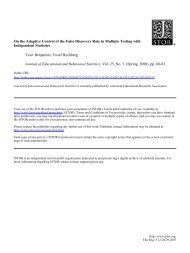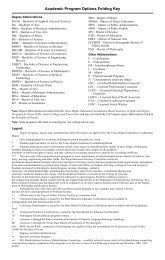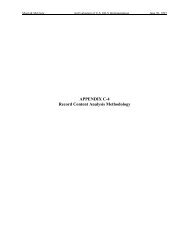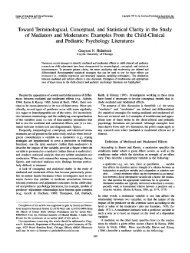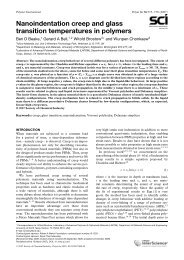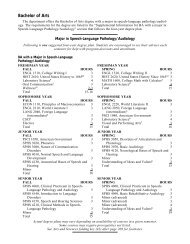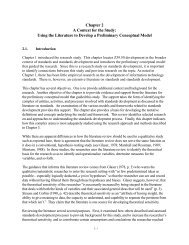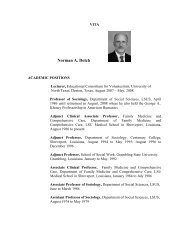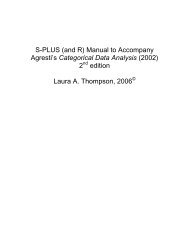Separation of gelation from vitrification in curing of a fiberâ€Âreinforced ...
Separation of gelation from vitrification in curing of a fiberâ€Âreinforced ...
Separation of gelation from vitrification in curing of a fiberâ€Âreinforced ...
Create successful ePaper yourself
Turn your PDF publications into a flip-book with our unique Google optimized e-Paper software.
<strong>Separation</strong> <strong>of</strong> Gelation From Vitrification<br />
<strong>in</strong> Cur<strong>in</strong>g <strong>of</strong> a Fiber-Re<strong>in</strong>forced Epoxy Composite<br />
BRYAN BILYEU and WITOLD BROSTOW<br />
Laboratory <strong>of</strong> Advanced Polymers and Optimized Materials (LAPOM)<br />
Department <strong>of</strong> Materials Science<br />
Unwerslty <strong>of</strong> North Texas<br />
P. 0. Box 305310<br />
Denton, ?x 76203-531 0<br />
and<br />
KEVIN P. MENARD<br />
Perk<strong>in</strong> Elmer Instruments<br />
761 Ma<strong>in</strong>Ave. F71<br />
Nowalk, CTO6987<br />
Prepregs <strong>of</strong> a mixture <strong>of</strong> the tetrafunctional epoxy tetraglycidyl 4.4-diam<strong>in</strong>odiphenyl<br />
methane (TGDDM) and the tetrafunctional am<strong>in</strong>e 4.4'-diam<strong>in</strong>odiphenylsulfone<br />
(DDS) were characterized with temperature-modulated DSC (TMDSC) as<br />
well as dynamic mechanical analysis (DMA). The basel<strong>in</strong>e shift <strong>of</strong> the glass transition<br />
was separated <strong>from</strong> the cur<strong>in</strong>g exotherm by us<strong>in</strong>g temperature-modulated and<br />
step scan DSC temperature scans. Likewise, the basel<strong>in</strong>e shift <strong>in</strong> heat capacity due<br />
to <strong>vitrification</strong> was isolated us<strong>in</strong>g TMDSC isotherms. Us<strong>in</strong>g the TMDSC glass transition<br />
temperature, degree <strong>of</strong> conversion, and <strong>vitrification</strong> results, comb<strong>in</strong>ed with<br />
the <strong>gelation</strong> data generated <strong>from</strong> DMA, a time-temperature-transformation (TIT) diagram<br />
was constructed, provid<strong>in</strong>g <strong>in</strong>formation necessary for optimization <strong>of</strong> <strong>in</strong>dustrial<br />
process<strong>in</strong>g <strong>of</strong> the epoxy prepreg. Thus, effects <strong>of</strong> storage, preprocess<strong>in</strong>g, and<br />
postprocess<strong>in</strong>g on the overall cur<strong>in</strong>g process are taken <strong>in</strong>to account.<br />
1. INTRODUCTION<br />
iber-re<strong>in</strong>forced epoxy prepregs are commonly<br />
F processed us<strong>in</strong>g isothermal cur<strong>in</strong>g. Although process<strong>in</strong>g<br />
appears simple, the development <strong>of</strong> properties<br />
dur<strong>in</strong>g cur<strong>in</strong>g is a complex multistep process. In addition,<br />
the relationship between the cur<strong>in</strong>g temperature<br />
and time to a specific conversion value is not l<strong>in</strong>ear.<br />
Industrial process<strong>in</strong>g control is simplified us<strong>in</strong>g a<br />
time-temperature-transformation (ITT) diagram.<br />
However, construction <strong>of</strong> such a TIT diagram requires<br />
knowledge <strong>of</strong> the rate and degree <strong>of</strong> conversion as well<br />
as the time to reach <strong>gelation</strong> and <strong>vitrification</strong> at each<br />
isotherm. The rate and degree <strong>of</strong> conversion is determ<strong>in</strong>ed<br />
either with a series <strong>of</strong> DSC isotherms, which<br />
show the change <strong>of</strong> enthalpy <strong>in</strong> time or with the<br />
change <strong>in</strong> the glass transition temperature Tg dur<strong>in</strong>g<br />
the isothermal cure. Accuracy and resolution <strong>of</strong> Tg<br />
measurements by DSC are improved by us<strong>in</strong>g heat<br />
capacity C, rather than enthalpy. S<strong>in</strong>ce <strong>gelation</strong><br />
appears as a change <strong>in</strong> physical properties, it is conveniently<br />
determ<strong>in</strong>ed by DMA. Vitrification as a rubber<br />
to glass transition appears <strong>in</strong> both DMA and DSC.<br />
Although <strong>vitrification</strong> is commonly determ<strong>in</strong>ed by<br />
DMA, DSC <strong>of</strong>fers <strong>in</strong>creased temperature accuracy and<br />
control. However, s<strong>in</strong>ce <strong>vitrification</strong> occurs before<br />
complete conversion, the Tg is usually masked by the<br />
cur<strong>in</strong>g exotherm <strong>in</strong> traditional DSC. S<strong>in</strong>ce <strong>vitrification</strong><br />
and cur<strong>in</strong>g are thermodynamically different effects,<br />
one should be able to separate the two signals by<br />
us<strong>in</strong>g either temperature modulated DSC (TMDSC) or<br />
step scan DSC.<br />
2. EPOXY CURE CHARACTERIZATION<br />
OPTIONS<br />
To obta<strong>in</strong> the most useful and reliable characterization<br />
<strong>of</strong> the cur<strong>in</strong>g process we need to consider <strong>in</strong> turn<br />
the options available. Characterization <strong>of</strong> the epoxy cur<strong>in</strong>g<br />
reaction and generation <strong>of</strong> a ??T diagram requires<br />
POLYMER COMPOSITES, DECEMBER 2002, Vol. 23, No. 6 1111
Bryan Bilyeu, Witold Brostow, and Kev<strong>in</strong> P. Menard<br />
knowledge <strong>of</strong> the rate and degree <strong>of</strong> cure as a function<br />
<strong>of</strong> time and temperature as well as the conditions<br />
which produce <strong>gelation</strong>, <strong>vitrification</strong>, full cure and<br />
degradation. The rate and degree <strong>of</strong> cure is typically<br />
tracked by a change <strong>in</strong> a cure-dependent property,<br />
such as the glass transition temperature Tg Gelation<br />
can be determ<strong>in</strong>ed by exam<strong>in</strong><strong>in</strong>g the molecular<br />
weight-dependent properties. S<strong>in</strong>ce <strong>vitrification</strong> is a<br />
rubber-to-glass transition, it results <strong>in</strong> a thermodynamic<br />
as well as a physical change. A detailed review<br />
<strong>of</strong> thermal analysis techniques applicable to epoxy<br />
characterization is available (1) as well as an extensive<br />
study us<strong>in</strong>g a variety <strong>of</strong> techniques to fully characterize<br />
an epoxy system (2).<br />
Many thermosett<strong>in</strong>g polymer systems exhibit a relationship<br />
between the Tg and the degree <strong>of</strong> chemical<br />
conversion. Most epoxy-am<strong>in</strong>e systems exhibit a l<strong>in</strong>ear<br />
relationship, which implies that the change <strong>in</strong><br />
molecular structure with conversion is <strong>in</strong>dependent <strong>of</strong><br />
the cure temperature (3).<br />
The most convenient and generally most accurate<br />
method for determ<strong>in</strong><strong>in</strong>g the Tg <strong>of</strong> polymers is differential<br />
scann<strong>in</strong>g calorimetry (DSC). The Tg is taken as<br />
the temperature at the <strong>in</strong>flection po<strong>in</strong>t (peak <strong>of</strong> derivative<br />
curve) <strong>of</strong> the basel<strong>in</strong>e shift <strong>in</strong> heat flow or as the<br />
temperature at the half height shift <strong>in</strong> basel<strong>in</strong>e heat<br />
flow. The shift <strong>in</strong> basel<strong>in</strong>e heat flow associated with<br />
the glass transition is a result <strong>of</strong> the difference <strong>in</strong> heat<br />
capacity between the rubber and the glass. S<strong>in</strong>ce this<br />
shift is an effect <strong>of</strong> the heat capacity change, resolution<br />
<strong>of</strong> the glass transition can be <strong>in</strong>creased by calculat<strong>in</strong>g<br />
and plott<strong>in</strong>g the constant pressure heat capacity,<br />
c,.<br />
The versatility <strong>of</strong> DSC to measure both exotherms<br />
and Tgs is also a limitation; when measur<strong>in</strong>g an uncured<br />
or a partially cured thermoset, a residual<br />
exotherm follows the Tg be<strong>in</strong>g measured, sometimes<br />
even overlapp<strong>in</strong>g. Accurate Tg calculations require<br />
stable basel<strong>in</strong>es before and after the transition and<br />
the cur<strong>in</strong>g exotherm <strong>in</strong>terferes with the upper basel<strong>in</strong>e.<br />
In these cases, the Tg can only be determ<strong>in</strong>ed as<br />
the onset.<br />
One alternative to the measurement <strong>of</strong> C, is temperature-modulated<br />
DSC (TMDSC). TMDSC utilizes a<br />
modulated temperature ramp. The basis for the modulation<br />
signals and evaluation, <strong>in</strong>clud<strong>in</strong>g the phase<br />
lag, is derived <strong>from</strong> electrical signal modulation <strong>in</strong> the<br />
electronics and telecommunications field. Analogous<br />
to dynamic mechanical analysis (DMA), TMDSC<br />
mathematically deconvolutes the response <strong>in</strong>to two<br />
types <strong>of</strong> signals, an <strong>in</strong>-phase and an out-<strong>of</strong>-phase response<br />
to the modulations, as well as produc<strong>in</strong>g an<br />
average heat flow.<br />
A Fourier transform deconvolutes the signal to produce<br />
an average heat<strong>in</strong>g rate (%”). an average heat<br />
flow (h& an amplitude <strong>of</strong> heat<strong>in</strong>g rate (4). an amplitude<br />
<strong>of</strong> heat flow (AJ and a phase angle between the<br />
heat<strong>in</strong>g rate and heat flow (cp)(4). Schawe’s technique<br />
(5-7) uses a l<strong>in</strong>ear response approach, which beg<strong>in</strong>s<br />
with the total heat capacity (CpT = hav/G) and <strong>in</strong>cludes<br />
a C, value calculated as the ratio <strong>of</strong> the heat flow amplitude<br />
to the heat<strong>in</strong>g rate amplitude, the complex<br />
heat capacity (C,’ = Ah/&). The complex heat capacity<br />
(C,’ ) is separated <strong>in</strong>to two components, real and<br />
imag<strong>in</strong>q:<br />
C,’ = C,’ + ic,”<br />
with C,’ represent<strong>in</strong>g the real, <strong>in</strong>-phase component,<br />
termed storage heat capacity, and C; represent<strong>in</strong>g<br />
the imag<strong>in</strong>ary, out-<strong>of</strong>-phase component, termed loss<br />
heat capacity. The two values are calculated us<strong>in</strong>g the<br />
phase angle, cp, between the signal and response:<br />
c,’ = c,*c0scp<br />
cp” = C,*S<strong>in</strong>cp (4)<br />
As <strong>in</strong> DMA measurements, the storage signal will<br />
<strong>in</strong>clude the elastic or <strong>in</strong>-phase response <strong>of</strong> the material,<br />
which <strong>in</strong> this case represent the molecular level responses,<br />
<strong>in</strong>clud<strong>in</strong>g glass transitions and melt<strong>in</strong>g. The<br />
loss signal represents viscous or out-<strong>of</strong>-phase events,<br />
which are the k<strong>in</strong>etic effects, such as stress relaxation<br />
and cur<strong>in</strong>g. The total heat capacity is the non-separated<br />
average signal, which is equivalent to the heat<br />
capacity signal produced by traditional DSC. In epoxy<br />
Tg shifts, this allows separation <strong>of</strong> the Tg <strong>from</strong> the<br />
exotherm.<br />
Gelation represents a change <strong>in</strong> mechanical properties,<br />
but typically not a change <strong>in</strong> conversion rate.<br />
Thus, <strong>gelation</strong> does not appear <strong>in</strong> calorimetric measurements.<br />
However, as already po<strong>in</strong>ted out by one <strong>of</strong><br />
us (8). it does appear prom<strong>in</strong>ently <strong>in</strong> DMA.<br />
Although <strong>vitrification</strong> is a thermal transition <strong>from</strong> a<br />
rubber to a glass and does appear <strong>in</strong> DSC measurements<br />
(9). the determ<strong>in</strong>ation <strong>of</strong> the po<strong>in</strong>t and quantification<br />
<strong>of</strong> the shift <strong>in</strong> basel<strong>in</strong>e heat flow or C, usually<br />
occurs around the end <strong>of</strong> the cur<strong>in</strong>g and as such is<br />
usually masked by the cur<strong>in</strong>g reaction exotherm. This<br />
is one <strong>of</strong> the clearest applications <strong>of</strong> TMDSC s<strong>in</strong>ce the<br />
cur<strong>in</strong>g exotherm appears <strong>in</strong> the loss C, and the <strong>vitrification</strong><br />
appears <strong>in</strong> the storage C, (10-12).<br />
The first epoxy ‘IT diagram, proposed by Gillham<br />
and Ems (13). was constructed <strong>from</strong> torsional braid<br />
analysis (TBA), a torsional DMA measurement. DMA<br />
has been used extensively to <strong>in</strong>vestigate the <strong>vitrification</strong><br />
po<strong>in</strong>t, and cont<strong>in</strong>ues to be the most common<br />
method. However, as determ<strong>in</strong>ed earlier by one <strong>of</strong> us<br />
(141, DMA produces higher Tg values than DSC because<br />
<strong>of</strong> the measurement <strong>of</strong> extr<strong>in</strong>sic mechanical<br />
properties rather than <strong>in</strong>tr<strong>in</strong>sic heat capacity and the<br />
poorer temperature control <strong>of</strong> the <strong>in</strong>strument. DSC<br />
could produce more accurate and mean<strong>in</strong>gful Tg and<br />
<strong>vitrification</strong> po<strong>in</strong>ts-if these transitions were separated<br />
<strong>from</strong> the cur<strong>in</strong>g exotherm. Thus, we turn to<br />
TMDSC. Can TMDSC isolate the Tg and <strong>vitrification</strong><br />
po<strong>in</strong>ts?<br />
In other words, on one hand we have several aspects<br />
<strong>of</strong> cur<strong>in</strong>g that all must be determ<strong>in</strong>ed. On the<br />
other hand, we have several techniques at our disposal.<br />
We need to def<strong>in</strong>e a comb<strong>in</strong>ation <strong>of</strong> techniques that<br />
1112 POLYMER COMPOSITES, DECEMBER 2002, Vol. 23, No. 6
<strong>Separation</strong> <strong>of</strong> Gelation From Vitn@ation<br />
will provide sufficient, reliable and if possible fast<br />
characterization <strong>of</strong> the cur<strong>in</strong>g process.<br />
3. EXPERTMENTAL<br />
Hercules (Hexcel) 8552 neat res<strong>in</strong> and glass fiberre<strong>in</strong>forced<br />
prepregs, which are a mixture <strong>of</strong> the tetrafunctional<br />
epoxy tetraglycidyl 4,4-diam<strong>in</strong>odiphenyl<br />
methane (TGDDM) and the tetrafunctional am<strong>in</strong>e 4,4'-<br />
diam<strong>in</strong>odiphenylsulfone (DDS), along with an ionic<br />
<strong>in</strong>itiator/accelerator and a thermoplastic modifier<br />
were studied. The fiber-re<strong>in</strong>forced prepregs conta<strong>in</strong> 66<br />
weight percent unidirectional glass fiber.<br />
DSC, TMDSC and Step Scan DSC experiments were<br />
performed on a Perk<strong>in</strong>-Elmer Pyris-1 DSC equipped<br />
with liquid nitrogen cool<strong>in</strong>g, operat<strong>in</strong>g on a W<strong>in</strong>dows<br />
NT platform. For comparison, DSC experiments<br />
were also performed on a Perk<strong>in</strong>-Elmer DSC-7 with<br />
ice coolant, operat<strong>in</strong>g on a UNIX platform. Both<br />
DSCs were calibrated for temperature and heat <strong>of</strong><br />
fusion with <strong>in</strong>dium as the standard, follow<strong>in</strong>g ASTM<br />
procedures.<br />
TMDSC scans were performed <strong>in</strong> two modes-<br />
Heat/Cool and IsoScan. Heat Cool runs are a 10°C<br />
heat<strong>in</strong>g at 2O"C/m<strong>in</strong>, followed by a 5°C cool<strong>in</strong>g at<br />
1O0C/m<strong>in</strong>, for the average heat<strong>in</strong>g rate <strong>of</strong> 5"C/m<strong>in</strong>.<br />
IsoScan runs were a 30 second isotherm followed by a<br />
5°C heat<strong>in</strong>g at lO"C/m<strong>in</strong>, which also yields the average<br />
rate <strong>of</strong> 5"C/m<strong>in</strong>. Tg values were calculated as the<br />
half height shift <strong>in</strong> basel<strong>in</strong>e storage C,. Exothermal<br />
changes <strong>in</strong> enthalphy <strong>in</strong> the loss C, were determ<strong>in</strong>ed<br />
by compar<strong>in</strong>g the area under the curve to the total.<br />
Isothermal TMDSC determ<strong>in</strong>ation <strong>of</strong> <strong>vitrification</strong> po<strong>in</strong>t<br />
experiments were performed <strong>in</strong> Heat/Cool mode,<br />
heat<strong>in</strong>g to 5°C above the isothermal temperature at<br />
10°C/m<strong>in</strong>. and cool<strong>in</strong>g to 5°C below at 10°C/m<strong>in</strong>. The<br />
<strong>vitrification</strong> po<strong>in</strong>t was calculated as the half height<br />
shift <strong>in</strong> basel<strong>in</strong>e storage C, just as traditional glass<br />
transitions are located.<br />
StepScan DSC scans <strong>in</strong>volve two steps: heat<strong>in</strong>g and<br />
isothermal. The scans were a 5°C <strong>in</strong>crease at 10°C/<br />
m<strong>in</strong>. followed by a 30 second isotherm, repeated cyclically.<br />
From this, a separated c, curve was generated.<br />
Tg and <strong>vitrification</strong> could be separated <strong>from</strong> the cur<strong>in</strong>g<br />
exotherm.<br />
DMA experiments were performed <strong>in</strong> both %po<strong>in</strong>t<br />
bendmg and parallel plate compression, carried out on a<br />
Perk<strong>in</strong>-Elmer DMA-7e us<strong>in</strong>g liquid nitrogen cool<strong>in</strong>g for<br />
scans and ice for isotherms, operat<strong>in</strong>g on a W<strong>in</strong>dows NT<br />
plafform. The DMA-7e was calibrated for temperature<br />
us<strong>in</strong>g <strong>in</strong>dium follow<strong>in</strong>g ASlW E1867-97 and for height<br />
us<strong>in</strong>g a quartz standard. The %po<strong>in</strong>t bend<strong>in</strong>g apparatus<br />
used on the 0.55 mm thick prepreg tapes was a 5 mm<br />
wide probe with 5 mm separation between supports.<br />
The bend<strong>in</strong>g program used 10 pm amplitude <strong>in</strong> position<br />
control. The parallel plate compression measurements<br />
were performed on 0.55 mm thick prepreg tapes us<strong>in</strong>g a<br />
5 mm diameter circular plate <strong>in</strong> a 10 pm amplitude position<br />
control. DMA tempemture scans were performed<br />
<strong>in</strong> both modes to determ<strong>in</strong>e the <strong>gelation</strong> temperature, as<br />
well as the <strong>in</strong>itial and f<strong>in</strong>alTg".<br />
4. GLASS TRANSITION TEMPERATURES<br />
The Tg shift <strong>in</strong> time for specific isothermal cur<strong>in</strong>g<br />
temperatures was determ<strong>in</strong>ed by TMDSC (Fig. I), Step<br />
Scan DSC (Fig. 2), standard DSC and DMA. TMDSC<br />
and Step Scan DSC produces similar values <strong>of</strong> glass<br />
transition temperature as a function <strong>of</strong> cur<strong>in</strong>g time<br />
and temperature. We chose to use TMDSC rather<br />
than Step Scan DSC because TMDSC was also used<br />
for the pseudo-isothermal measurements <strong>of</strong> <strong>vitrification</strong>.<br />
These values were consistent with standard DSC<br />
and lower than DMA results. However, the DSC values<br />
were only measurable as onset values because <strong>of</strong><br />
the overlap <strong>of</strong> the cur<strong>in</strong>g exotherm. The DMA values<br />
were consistently higher because we were measur<strong>in</strong>g<br />
the mechanical properties that are results <strong>of</strong> the glass<br />
transition rather than the actual change <strong>in</strong> <strong>in</strong>ternal<br />
specific heat.<br />
The TMDSC values were tabulated and the shift for<br />
various isotherms are plotted as a function <strong>of</strong> time <strong>in</strong><br />
Rg. 3. The curves demonstrate an <strong>in</strong>crease <strong>in</strong> the rate<br />
and higher f<strong>in</strong>al Tg for higher cur<strong>in</strong>g temperatures.<br />
Us<strong>in</strong>g a logarithmic scale, a l<strong>in</strong>ear plot is generated <strong>in</strong><br />
Rg. 4. This l<strong>in</strong>ear plot is used to determ<strong>in</strong>e the shift<br />
factor between different cur<strong>in</strong>g temperatures.<br />
While the TMDSC measurements were used for the<br />
shift calculation, we note that the step change <strong>in</strong> heat<br />
capacity did decrease with <strong>in</strong>creas<strong>in</strong>g degree <strong>of</strong> cure<br />
ow<strong>in</strong>g to the high crossl<strong>in</strong>k density.<br />
5. GEL POINTS<br />
The gel po<strong>in</strong>t was measured as the peak <strong>in</strong> tangent<br />
delta <strong>from</strong> parallel plate DMA measurements, as<br />
shown <strong>in</strong> a 160°C isotherm <strong>in</strong> Rg. 5 and a series <strong>of</strong><br />
different isotherms <strong>in</strong> FQ. 6. Gelation was also seen<br />
as a poorly resolved peak <strong>in</strong> the 3-po<strong>in</strong>t bend<strong>in</strong>g DMA<br />
measurements shown <strong>in</strong> FQ. 7 for a 160°C isotherm:<br />
it occurred at comparable values, but clearly parallel<br />
plate is the technique we recommend.<br />
6. VITRIFICATION<br />
Vitrification was determ<strong>in</strong>ed us<strong>in</strong>g TMDSC and<br />
DMA <strong>in</strong> both 3-po<strong>in</strong>t bend<strong>in</strong>g and parallel plate<br />
modes. Us<strong>in</strong>g TMDSC, virncation was determ<strong>in</strong>ed as<br />
the basel<strong>in</strong>e shift <strong>in</strong> isothermal TMDSC measurements,<br />
as seen <strong>in</strong> the series <strong>in</strong> Q. 8.<br />
For comparison, <strong>vitrification</strong> was also measured by<br />
3-po<strong>in</strong>t bend<strong>in</strong>g DMA experiments. The result<strong>in</strong>g tangent<br />
delta curves for a series <strong>of</strong> isotherms are shown<br />
<strong>in</strong> Fig. 9. Vitrification also appeared <strong>in</strong> the parallel<br />
plate DMA measurements shown earlier <strong>in</strong> Fig. 5 as<br />
poorly resolved peaks.<br />
As expected, the DMA <strong>vitrification</strong> times were consistently<br />
higher for all isotherms because <strong>of</strong> the measurement<br />
<strong>of</strong> extr<strong>in</strong>sic properties rather than the <strong>in</strong>tr<strong>in</strong>sic<br />
heat capacity <strong>of</strong> the TMDSC. The larger sample<br />
size and the temperature control system means that<br />
the accuracy <strong>of</strong> transition temperatures are much<br />
lower than DSC, TMDSC <strong>in</strong> particular. Thus, we have<br />
POLYMER COMPOSITES, DECEMBER 2002, Vol. 23, No. 6 1113
1 , *.O 1.8<br />
Byan Bilyeu, Witold Brostow, and Kev<strong>in</strong> P. Menard<br />
0<br />
g 1,2<br />
a,<br />
P<br />
v)<br />
1 .o<br />
0.8<br />
V."<br />
I<br />
-50 0 50 100 1 :0 200 250 300<br />
Temperature ('C)<br />
Q. 1. Changes <strong>in</strong> Tg as afunction <strong>of</strong> the degree <strong>of</strong> we, as seen <strong>in</strong> the storage he& capacities <strong>of</strong> separated TMDSC scans.<br />
an answer to one <strong>of</strong> the questions asked at the end <strong>of</strong><br />
Section 2. We recommend TMDSC as the technique <strong>of</strong><br />
choice for the determ<strong>in</strong>ation <strong>of</strong> <strong>vitrification</strong>.<br />
7. TEE TTT DIAGRAM<br />
A time-temperature-transformation (TIT) diagram<br />
(Fig. 10) was constructed <strong>from</strong> the best resolved <strong>gelation</strong><br />
and <strong>vitrification</strong> data. The <strong>in</strong>itial Tg was determ<strong>in</strong>ed<br />
by TMDSC with DMA %po<strong>in</strong>t bend<strong>in</strong>g <strong>in</strong>cluded<br />
for comparison. The f<strong>in</strong>d Tg was measured by TMDSC<br />
and DMA %po<strong>in</strong>t bend<strong>in</strong>g. The DMA are the best resolved,<br />
due to the high filler content. The <strong>in</strong>crease <strong>in</strong><br />
Tg with time at various temperatures was measured<br />
by TMDSC. Gelation was measured by DMA parallel<br />
plate while <strong>vitrification</strong> was measured by TMDSC. The<br />
regions and transitions identified follow conventions<br />
proposed by Gillham.<br />
At temperatures below the Tgo (6°C) there is no reaction,<br />
so this is the safe storage temperature. Between<br />
Tgo and Tg.gel (6 to 86OC) the material will react, albeit<br />
very slowly, and will eventually vitnfy before it gels.<br />
Between Tg.ge, and Tg-.t (86 to 248°C) the material will<br />
first gel, then vitrrfy. Above Tg.~t (248°C) the material<br />
will gel, but will not vitrify. This diagram provides an<br />
easy-to-read description <strong>of</strong> the transformations tak<strong>in</strong>g<br />
place <strong>in</strong> process<strong>in</strong>g <strong>of</strong> composite prepregs and allows<br />
manipulation <strong>of</strong> process<strong>in</strong>g conditions to modify physical<br />
properties toward desired ranges <strong>of</strong> values.<br />
8. CONCLUDING REMARKS<br />
In summary, TMDSC and step scan DSC provide<br />
improved accuracy over common DMA <strong>in</strong> Tg and <strong>vitrification</strong><br />
measurements without the overlap <strong>of</strong> the<br />
cur<strong>in</strong>g exotherm <strong>in</strong> traditional DSC. This is due to<br />
improved temperature control, small sample size and<br />
the measurement <strong>of</strong> heat capacity rather than mechanical<br />
properties. Gelation should be measured by<br />
DMA s<strong>in</strong>ce it <strong>in</strong>volves molecular weight and crossl<strong>in</strong>k<br />
density effects. This comb<strong>in</strong>ation <strong>of</strong> techniques provides<br />
the <strong>in</strong>formation necessary for a TIT diagram<br />
which characterizes an epoxy system.<br />
In this paper we have studied a commercial epoxy.<br />
We are also work<strong>in</strong>g on chemical epoxy modification<br />
(15-17). We <strong>in</strong>tend to venfy <strong>in</strong> the future whether the<br />
modified epoxies lend themselves to the same approach-<strong>in</strong>clud<strong>in</strong>g<br />
the development <strong>of</strong> TIT diagrams.<br />
1114 POLYMER COMPOSITES, DECEMBER 2002, Vol. 23, No. 6
<strong>Separation</strong> <strong>of</strong> Gelation From Vitriiation<br />
T4 <strong>of</strong> Epoxy by Step Scan DSC<br />
Rg. 2. Step Scan DSC temperahue SCM<br />
with the Tg identified and the cur<strong>in</strong>g<br />
exotherm elim<strong>in</strong>ated.<br />
235<br />
250<br />
Tg Shift <strong>in</strong> Time<br />
L<br />
v 150<br />
0<br />
0 100 200 300 400 500 600 700 800<br />
Time (m<strong>in</strong>utes)<br />
FYg. 3. Ship <strong>in</strong> Tg <strong>in</strong> t<strong>in</strong>ze for isothermal cure diagrams.<br />
POLYMER COMPOSITES, DECEMBER 2002, Vol. 23, No. 6 1115
Bryan Bilyeu, Witold Brostow, and Kev<strong>in</strong> P. Menard<br />
time (m<strong>in</strong>utes<br />
Fig. 4. Shift <strong>in</strong> Tg <strong>in</strong> time for isothermal cure temperatures on the logarithmic scale.<br />
Q30 1<br />
8851 660<br />
m<br />
7WaOOO<br />
6000000 1<br />
Fig. 5. A parallel plate DMA<br />
isotherm at 160°C show<strong>in</strong>g peak<br />
<strong>in</strong> tangent delta at <strong>gelation</strong>.<br />
an Delta<br />
5oOoM30 5<br />
1)<br />
4omo j<br />
3000000<br />
u<br />
;<br />
Vitrification<br />
2000000<br />
1ooOooO<br />
ILos;<br />
0 .oo<br />
Modul<br />
5 10 20 30 40 50 60 70 75<br />
Tm (mm)<br />
-421 369<br />
1116 POLYMER COMPOSITES, DECEMBER 2002, Vol. 23, No. 6
<strong>Separation</strong> <strong>of</strong> Gelation From Vitr$cation<br />
Gel Po<strong>in</strong>t by DMA Parallel Plate Isotherms<br />
0.32 1<br />
Fig. 6. A series <strong>of</strong> parallel plate<br />
DUA isotherms show<strong>in</strong>g the sht<br />
<strong>in</strong> time to <strong>gelation</strong> for different<br />
temperatures.<br />
0. T<br />
I 0.6<br />
Three-Po<strong>in</strong>t Bend<strong>in</strong>g<br />
I 0.5<br />
I<br />
c<br />
? 0.3<br />
0.2<br />
0.1<br />
0.0<br />
20 ao 60 80 1 00 120 1 40 160 I 80 200<br />
Time [m<strong>in</strong>)<br />
Rg. 7. A 3po<strong>in</strong>t bend<strong>in</strong>g DMA isotherm at 160°C show<strong>in</strong>g <strong>gelation</strong> as a poorly resolved peak before the d e ? vi@@ation peak.<br />
POLYMER COMPOSITES, DECEMBER2002, Vol. 23, No. 6 1117
Bryan Bifyeu, Witold Brostow, and Kev<strong>in</strong> P. Menard<br />
1 Vitrification by TMDSC<br />
3.2 -<br />
Rg. 8. Series <strong>of</strong> TMDSC isothenns<br />
with vh$cation measured as the<br />
hdf height shii <strong>in</strong> basel<strong>in</strong>e storage<br />
cp.<br />
n<br />
u 311 -<br />
P<br />
2<br />
1<br />
r 213<br />
I<br />
0<br />
E<br />
: 2.6<br />
6<br />
2.2 i<br />
31<br />
L.1 I I I I I I I<br />
0 50 I00 150 200 250 299.9<br />
Time (m<strong>in</strong>)<br />
0.50<br />
Rg. 9. A series <strong>of</strong> 3-po<strong>in</strong>t bend<strong>in</strong>g<br />
DMA isotherms show<strong>in</strong>g the shii<br />
<strong>in</strong> time to vitntation for difjkrent<br />
temperatures.<br />
I<br />
0.45<br />
0.40<br />
1<br />
0.35<br />
0.30<br />
m<br />
r<br />
;<br />
m<br />
0.25<br />
m<br />
I-<br />
0 .a<br />
0.15<br />
0.1 0<br />
0.05<br />
0.M<br />
10 20 30 40 50 60 70 m 90 loo 110 im 130<br />
Time (m<strong>in</strong>)<br />
1118 POLYMER COMPOSITES, DECEMBER 2002, Vol. 23, No. 6
<strong>Separation</strong> <strong>of</strong> Gelation From Vitriiation<br />
TTTDiagm for TGDDMiDD6<br />
3orJ [<br />
m. 10. Time temperature transformation<br />
diagram for the EDDM<br />
+ DDS system with <strong>gelation</strong> and<br />
vitriiation curves identijkd. The<br />
<strong>in</strong>itial Tg used for the cwue was<br />
determ<strong>in</strong>ed by DSC; however, the<br />
uaimjiom DMA 3-po<strong>in</strong>t bend<strong>in</strong>g is<br />
<strong>in</strong>cluded as po<strong>in</strong>ts for comparison.<br />
The <strong>gelation</strong> po<strong>in</strong>ts were determ<strong>in</strong>ed<br />
by DMA parallel plate measurements.<br />
The po<strong>in</strong>ts used to construct<br />
the vitriiation curve were<br />
determ<strong>in</strong>ed by TMDSC; also here,<br />
values <strong>from</strong> DMA 3-po<strong>in</strong>t bend<strong>in</strong>g<br />
are <strong>in</strong>cluded as experimental<br />
po<strong>in</strong>ts for comparison. %_f<strong>in</strong>al Tg<br />
values were determ<strong>in</strong>ed by DMA<br />
3-po<strong>in</strong>t bend<strong>in</strong>g and TMDSC, with<br />
DMA S-pO<strong>in</strong>t bend<strong>in</strong>g values US&<br />
to construct the curve.<br />
‘I ‘10 109 ,IOM 10~<br />
time (m<strong>in</strong>)<br />
ACKNOWLEDGMENTS<br />
Partial f<strong>in</strong>ancial support has been provided by the<br />
State <strong>of</strong> Texas Advanced Research Program, Aust<strong>in</strong><br />
(project # 003594-0075) and the Robert A. Welch<br />
Foundation, Houston (grant # B-1203).<br />
REFERENCE!3<br />
1. B. Bilyeu. W. Brostow, and K. P. Menard, J. Mater. Ed,<br />
21, 281 (1999).<br />
2. B. Bilyeu, MS Thesis, University <strong>of</strong> North Texas, Denton<br />
(1999).<br />
3. G. Wisanrakkit and J. K. Gillham. Polymer Characterization,<br />
Eds. C. Craver and T. Provder, Ch. 9, American<br />
Chemical Society, Wash<strong>in</strong>gton D.C. (1990) 143.<br />
4. J. M. Hutch<strong>in</strong>son and S. Montserrat, mermoChim Act&<br />
3041306 (1997) 257.<br />
5. J. E. K. Schawe, Themhim Acta 270 (1995) 1.<br />
6. J. E. K. Schawe. Thermochim. Actu, 261 (1995) 183.<br />
7. J. E. K. Schawe, Thermochim. Acta, 260 (1995) 1.<br />
8. K. P. Menard, Dynamic Mechanical Analysis, CRC Press,<br />
Boca Raton (1999).<br />
9. M. Cassettari, G. Salvetti, E. Tombari, S. Veronesi, and<br />
G. P. Johari, J. Pol~~rn SA, 31 (1998) 199.<br />
10. B. Bdyeu, W. Brostow, and K. Menard, Materials Characterization<br />
by Dynamic and Modulated Thermal<br />
Analytical Techniques, ASTM STP 1402, American<br />
Society for Test<strong>in</strong>g and Materials, West Conshocken, Pa.<br />
(2000).<br />
11. C. Schick, J. Dobberth. M. Potter, H. Dehne, A. Hensel.<br />
A. Wurm, A. M. Ghoneim, and S. Weyer, J. Therm.<br />
And. 49 (1997) 499.<br />
12. G. Van Assche, A. Van Hemelrjjck, H. Fbhier, and B.<br />
Van Mele, Thermochim Acta, 3041505 (1997) 317.<br />
13. J. K. illh ham, NC~E<br />
J., ao (1974) 1066.<br />
14. H. R. O’Neal, S. Welch, J. Rogers, S. Guilford, G.<br />
Curran, and K. P. Menard, J. Adu. Mater., 26 (1995) 49.<br />
15. L. Bazyliak, M. Bratychak. and W. Brostow, Mater. Res.<br />
rwv., 3 (1999 132.<br />
16. M. Bratychak and W. Brostow, Polym. Eng. Sci, 39<br />
(1999) 1541.<br />
17. L. Bazyliak, M. Bratychak, and W. Brostow, Mater. Res.<br />
Innov.. 3 (2000) 218.<br />
POLYMER COMPOSITES, DECEMBER 2002, Vol. 23, No. 6 1119



